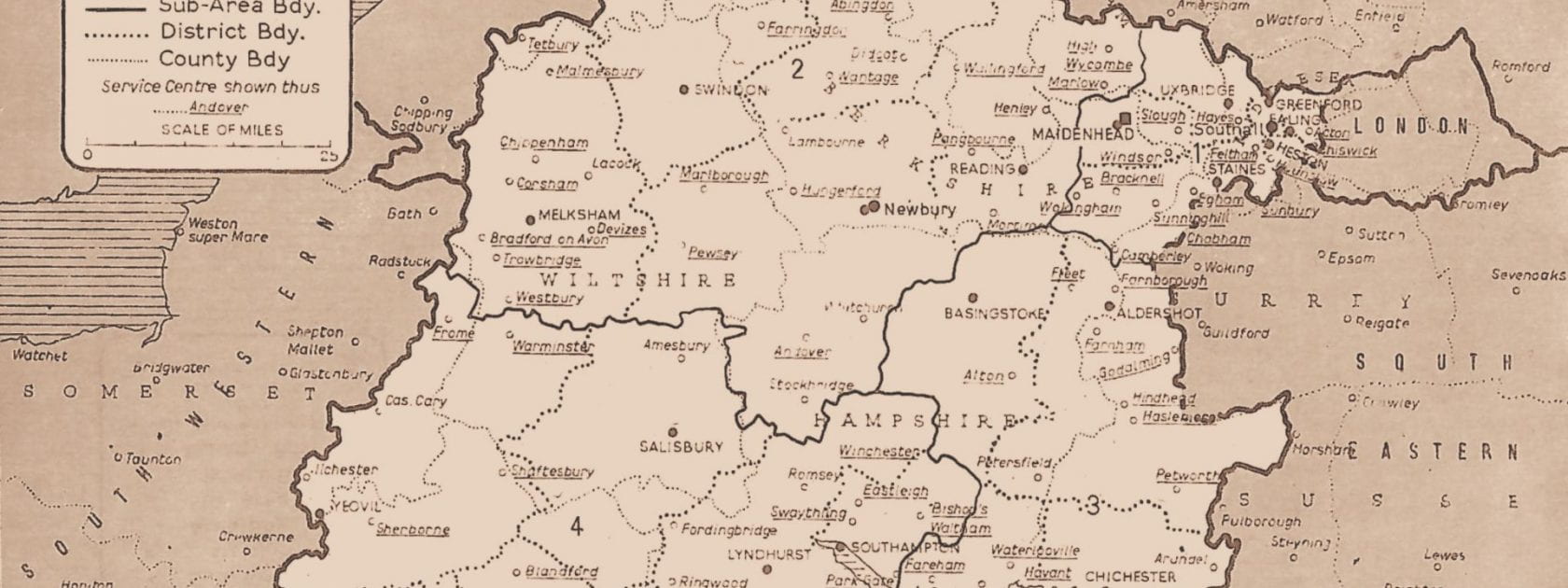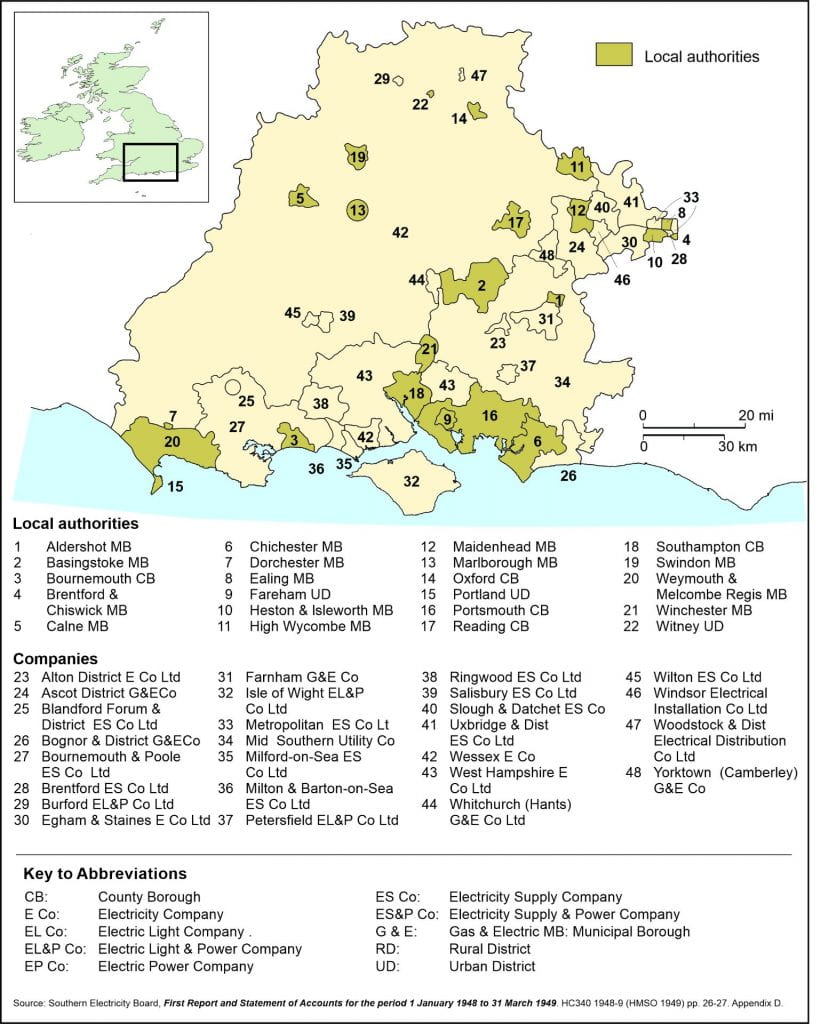Development of Southern Electricity Supply Areas
The 1948 pattern illustrated in Figure 1 represented the climax of over 50 years of development. Unusually for a new innovation, electricity for public supply was subject to tight national regulations from an early stage. The Electric Lighting Act 1882 required “undertakings” to apply for a licence or provisional order from the Board of Trade.[5] This requirement followed the precedents for earlier public utilities which had to “break up the streets” to lay mains or tracks. Electric Lighting Orders provided the basic conditions of a franchise to operate within a defined area, limiting the maximum prices that could be charged to consumers and, for private companies, a time limit of 21 years after which the local authority could purchase the system. An amendment in 1888 extended the time period to 42 years. All the Electric Lighting Orders were subject to Parliamentary approval. Major changes such as amalgamation of companies and extension of area required special acts.
Only a few public electricity systems were established under the 1882 Act. By 21 December 1882 the Board of Trade had received 109 applications for Electric Lighting Orders. After scrutiny by the office and Parliament, 69 ELOs were granted to local authorities and companies. Eight of these came to fruition over the next decade, while the others were abandoned as the early optimism waned given the uncertainties of the market for electricity and the limitations of the early technology.
Figure 1 and Table 1 Constituent Areas of the Southern Electricity Board, 1948.
Three of the applications in 1882 came from the Southern area. An ELO was granted to the Metropolitan (Brush) Electric Light and Power Co. for Chiswick, only part of the application which had included Fulham, Acton and Ealing. The application by the Provincial (Brush) Electric Light and Power Co. for High Wycombe was also successful. The Union Electric Light and Power Co.’s application for a franchise in Southampton was, however “…not considered as the provisions of the Act had not been complied with.”[6] Since the British companies were unable to implement the local schemes, the ELOs for Chiswick and High Wycombe were revoked in 1884.
The experimental public lighting project in Godalming, opened in September 1881, also came to an end in 1884.[7] Siemens Brothers, suppliers of the operating equipment and later managers of the small system, were unable to build up a viable market for electricity at that time. In September 1981 the Southern Electricity Board was a major sponsor of a week’s events celebrating the centenary of the first “public electricity in the world”.[8]
Although general urban electrification failed to take off in the region, private systems began to develop. Private systems provided a market for electrical equipment, helped in the training of electrical workers, and gave opportunities to refine details of the new technology. Examples of private systems in the area include the installation of electric lighting at Windsor Castle and Blenheim Palace and the electrification of the St Catherines Point lighthouse on the Isle of Wight. In 1886 Siemens built the Ryde Pier electric tramway which operated successfully until 1927.[9]
Public electricity supply schemes began to take off in 1889-90 when applications for Electric Lighting Orders resumed. Nationally, there were 17 applications in 1889 and 161 in 1890. Six ELOs were granted for towns in the Southern area in 1890: Bognor, Bournemouth (2), Oxford, Portsmouth and Windsor.[10] The inaction of the promoters in Bognor and the South of England House-to-House Company in Bournemouth led to these ELOs being revoked in 1892. The Windsor ELO was revoked in 1892. The three other promoters built successful local systems.
While the Board of Trade developed regulations for safety, inspected and approved new systems as well as collecting annual returns, the Board provided no guidance on general policy or technical matters. These were left to the operator and consulting engineer to decide. Consequently after 1888 large numbers of fragmented operators developed DC and AC systems with little attempt at co-ordination. AC systems with frequencies varying from 25 cycles (Hz) to 100 cycles were established. The lack of standardisation would become a major problem when interconnection between areas became advantageous.
An outline of development is presented in three phases: local initiatives from the 1880s to World War I, state intervention to the 1940s and nationalisation from 1948.
[5] Basic details of this Act and subsequent legislation are outlined in Electricity Supply in Great Britain: A chronology (London: Electricity Council, 1977).
[6] “Report by the Board of Trade respecting the applications to and Proceedings of, the Board of Trade under the Electric Lighting Act 1882.” Parliamentary Papers 1883. HC 237.
[7] The opening was noted in The Engineer, Vol 52, 1881, p.245. See also: “The “Old Mill on the Stream”, chapter 4 in Gavin Weightman, Children of Light: How electricity changed Britain forever (London: Atlantic Books, 2011).
[8] Southern Electricity Board, Annual Report 1982-82. The Electricity Council also sponsored an exhibition at the Science Museum.
[9] The Telegraphic Journal and Electrical Review Vol 18, 18 March 1886, p.251.
[10] Board of Trade, Proceedings under the Electric Lighting Acts. Parliamentary Papers 1890. HC 273.



